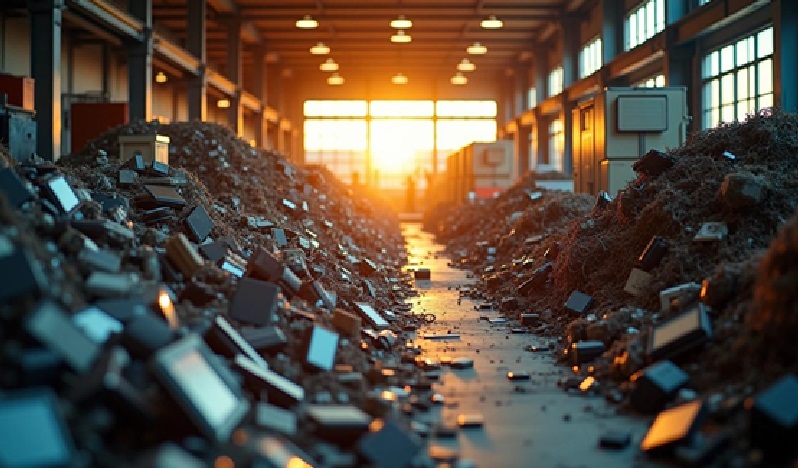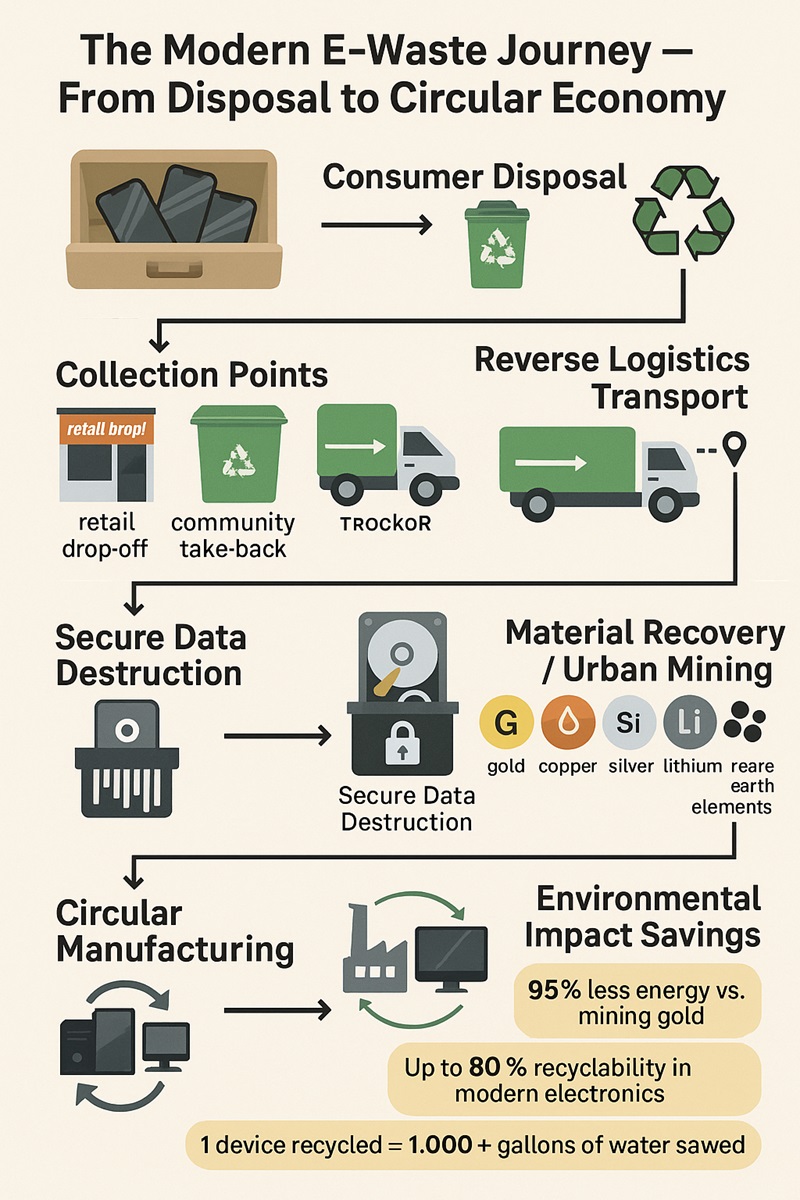Electronic waste is growing at a speed the world is struggling to contain. In 2022 alone, humanity produced more than 62 million metric tons of e-waste — enough to fill over 1.5 million 40-ft shipping containers. Yet less than 20% of it was recycled properly. The rest leaked toxic metals into soil, contaminated waterways, or sat forgotten in drawers, quietly losing value.
What most people don’t see is that these discarded devices are not simply “trash.” They’re mini-mine sites — rich in gold, copper, palladium, and rare earth elements. The problem isn’t just pollution; it’s the extraordinary waste of recoverable materials.
Sustainable e-waste programs are designed to repair this imbalance, creating smarter pathways for collection, reuse, recycling, and circular manufacturing.
What Is E-Waste and Why It Matters
E-waste is old electronics you no longer use. It includes any device with a plug or battery. Many of these items have harmful parts, so safe recycling is important. New tech grows fast, but recycling systems grow slowly. This gap makes e-waste a big problem for people and the planet.
Common Types of E-Waste
E-waste comes in many forms. It includes home items like fridges, AC units, and microwaves. It also includes laptops, printers, and monitors. TVs, game consoles, and speakers are part of it too. Phones, tablets, and e-readers count as well. Even medical tools can turn into e-waste.
In 2022, each person made about 7.8 kg of e-waste — and this amount is still going up.
Environmental and Health Risks
When e-waste ends up in landfills or informal recycling yards, toxic metals such as lead, cadmium, and mercury seep into soil, groundwater, and air.
What is less widely known is that one metric ton of circuit boards contains more gold than one ton of mined ore — yet we recover only a fraction of it.
Exposure to improperly handled e-waste has been linked to:
- Reproductive disorders
- Higher risks of stillbirth
- Behavioral and learning challenges in children
- Respiratory damage
- Thyroid disruptions
- Elevated blood lead levels
These impacts are especially severe in developing regions where informal recycling — often done by burning components or using acid baths — still dominates.
The Human Cost — Informal Recycling Hotspots
In countries like Ghana (Agbogbloshie) and China (Guiyu), e-waste often arrives illegally from wealthier nations. Workers, including children, extract metals using open fires or crude tools. Studies show:
- Children in Guiyu once had blood lead levels six times higher than international safety limits.
- Burning cables releases dioxins up to 100x higher than safe air quality thresholds.
Any modern e-waste strategy that doesn’t address these global inequalities is incomplete. Sustainable programs aim to replace informal recycling with safer, regulated alternatives — while helping impacted communities transition to formal jobs.
Global Policy Landscape (EU WEEE, US, Asia)
A complete e-waste system requires clear rules. Around the world, governments take different paths:
European Union — WEEE Directive
The world’s strongest e-waste law.
- Mandatory producer responsibility
- Repairability scoring
- Free consumer take-back
- 65% annual collection target
United States
Fragmented. Only 25 states + D.C. have formal e-waste laws. No national framework.
Japan Home Appliance Recycling Law
Manufacturers must collect and recycle major appliances. Citizens pay a recycling fee upfront.
Singapore’s Extended Producer Responsibility (EPR)
Producers must finance nationwide collection and meet strict recovery rates.
India (E-Waste Rules 2022)
Mandatory EPR targets and traceability, but enforcement gaps remain.
Understanding these policy differences helps explain why recycling rates vary dramatically across regions.
Why People Don’t Recycle
Many people keep old electronics for years. There are simple reasons for this. Some think they might use the device again. Some worry someone could steal their data. Others do not have a recycling center close to them. Many people feel attached to their old phones or laptops. Some people are not sure what counts as e-waste at all.
Surveys show that 31% of people still throw electronics in the trash. This happens mostly because people do not know the right way to recycle. Clear information and easy choices can help change this.
How We Can Reduce E-Waste
We can all help reduce e-waste in small, easy ways.
Use your devices longer. Try to fix them before buying new ones. If the device still works, donate it to someone who needs it.
Recycle in the right way. Certified centers can take devices apart and save important metals. Today, only 22.3% of e-waste is recycled the right way. We can improve this number by making recycling easy.
You can also support take-back programs from tech brands. Many companies now offer free drop-off options. Some laws even require brands to plan for the end of a product’s life, so designs become safer and easier to recycle.
Right-to-Repair & Sustainable Product Design
Sustainable waste management begins long before a device reaches the trash.
Modern circular design innovations include:
- Modular smartphones (Fairphone, Framework)
- Easily removable batteries
- Durability scoring labels (EU)
- Repairability standards and availability of spare parts
- Materials chosen for recyclability rather than cost alone
Companies that prioritize repairability and disassembly significantly reduce the burden on recycling systems.
Urban Mining — The New Gold Rush
Urban mining refers to recovering precious metals from discarded electronics. It is now far more resource-efficient than traditional mining.
- Gold yield from e-waste: up to 100x higher than gold ore
- Up to 95% less energy required to process recovered metals
- Growing revenue opportunity for recyclers and governments
Japan famously sourced the metals for the 2020 Olympic medals entirely from urban-mined e-waste — an industry milestone.
Renewable Tech Waste (Solar Panels, EV Batteries)
E-waste is no longer limited to phones and laptops.
- Solar panels have a 20–25-year lifespan and contain valuable silicon and silver.
- EV batteries are surging in volume and require specialized recycling for cobalt, nickel, and lithium.
- Wind turbine blades, made of composite materials, pose disposal challenges.
Adding these categories to e-waste programs is crucial for the sustainability of clean energy transitions.
How Sustainable E-Waste Collection Programs Work
Strong recycling systems begin with strong collection models. These provide clear, convenient pathways for electronics to reach certified facilities.
Collection Points and Take-Back Programs
People recycle more when the process is easy. They can use community drop-off sites, store collection bins, or take-back programs from brands. In the UK, bright pink bins in Cambridge collected 49 tons of small electronics. In Singapore, national rules make producers build and run collection systems.
Role of Public Awareness and Education
Awareness is a powerful driver. Campaigns, school programs, and community workshops help citizens understand:
- Where to recycle
- Why e-waste is hazardous
- How recycling preserves valuable resources
Studies show individuals with e-waste education are significantly more likely to recycle properly.
Tracking and Inventory Systems
Modern programs rely on digital tools to ensure transparency.
- Batch tracking of items
- Chain-of-custody documentation
- Certificates of recycling and data destruction
These reinforce public trust, regulatory compliance, and secure handling of sensitive devices.
The Role of Reverse Logistics in E-Waste Management
Reverse logistics moves used devices back through the supply chain. It includes collection, transportation, repair, and recycling. This global industry was worth $768 billion in 2023 and may reach $1.17 trillion by 2032.
Electronics reverse logistics cuts pollution, lowers mining needs, and recovers useful metals. But it also faces challenges. Transport costs are high. Rules differ across regions. Many groups lack awareness. Some devices are hard to take apart.
E-waste Recycle Examples
Apple “Daisy” Robot
- Disassembles 200+ iPhones per hour
- Recovers rare earth metals with >95% precision
Dell Closed-Loop Plastics
- Recycles plastic from old devices into new Dell product casings
- Reduces energy use by up to 44%
South Korea’s Municipal Recycling Model
- One of the world’s highest e-waste recovery rates
- Community convenience is the secret to success
Technology and Compliance in Sustainable Recycling
AI-driven automation is transforming recycling.
AI and Robotics
- Robots sort materials with 95% accuracy
- Machine-learning systems recognize 30+ components
- CPS networks monitor performance in real time
Certifications: R2 & e-Stewards
Certified recyclers must prove:
- Safe recycling practices
- Secure data destruction
- Full traceability of materials
Regulations
- 25 U.S. states + D.C. enforce electronics recycling laws
- Blockchain is emerging as the next frontier of transparent material tracking
Conclusion: A Circular Future Is Within Reach
Strong e-waste systems help us turn old devices into new resources. With easy collection, better design, smart transport, and advanced tech, we can cut pollution, save metals, and protect communities. A circular electronics system needs everyone—consumers, businesses, governments, and manufacturers—to take part.




